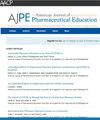Exploring an Introduction to Electronic Medical Record–Based Assessment of Medication Orders Among Novice Student Pharmacists
IF 3.5
4区 教育学
Q1 EDUCATION, SCIENTIFIC DISCIPLINES
引用次数: 0
Abstract
Objective
To pilot an electronic medical records (EMRs) simulation activity that incorporates a medication verification process, aimed at exploring novice learners’ interactions with the system, as well as their perceptions and confidence in verifying medication orders.
Methods
A quasi-experimental study was conducted using a simulated EMR platform, MyDispense. The study consisted of 5 medication orders, where students were asked to either select “verify” or “reject” each order. The activity was piloted by 390 second-year students across Australia and Malaysia. Verification actions and common mistakes were exported from MyDispense. Student perception and confidence data were collected using pre and postsurveys. An expert panel reviewed the data and suggested a scaffolded curriculum.
Results
The majority of students (80.5%–94.4% across cases) correctly selected the appropriate medication verification option. Common mistakes included incorrect selections on the issues for review form, such as specifying incorrect medication duration and indication. When orders were pitched to be clinically gray but safe to administer, novice learners showed a preference for rejection. Preactivity survey responses totaled 277, and postactivity responses were 261. There was a statistically significant increase in perceived confidence, with scores rising from 3 to 4 on a 5-point Likert scale, indicating improved confidence in EMR medication verification. A scaffolded curriculum incorporating milestones of experiential placements was recommended.
Conclusion
While students’ perceived confidence in medication verification increased overall, the study highlighted a potential need for educators to prepare students for clinical documentation and discussions by encouraging them to log interventions and partake in conversations with the prescribing team outside of the electronic verification process.
基于电子病历的药单评估在药学新生中的应用探讨。
目的:试点一个包含药物验证过程的电子医疗记录(EMR)模拟活动,旨在探索新手学习者与系统的互动,以及他们对验证药物订单的看法和信心。方法:采用模拟EMR平台MyDispense™进行准实验研究。这项研究包括五个药物订单,学生们被要求选择“验证”或“拒绝”每个订单。这项活动由澳大利亚和马来西亚的390名二年级学生试行。验证操作和常见错误从MyDispense™导出。学生的认知和信心数据通过前后调查收集。一个专家小组审查了数据,提出了一个框架式的课程。结果:大多数学生(80.5 ~ 94.9%)能正确选择合适的药物验证选项。常见的错误包括对审查表格问题的错误选择,例如指定不正确的药物持续时间和适应症。当命令被定位为临床灰色但安全管理时,新手学习者倾向于拒绝。活动前的问卷调查共有277份,活动后的问卷调查有261份。感知信心在统计学上显著增加,在5分李克特量表上得分从3分上升到4分,表明对EMR药物验证的信心提高。建议采用包含里程碑式体验的脚手架式课程。结论:虽然学生对药物验证的信心总体上有所增加,但研究强调了教育工作者的潜在需求,即鼓励学生记录干预措施,并在电子验证过程之外与处方团队进行对话,从而使学生为临床文件和讨论做好准备。
本文章由计算机程序翻译,如有差异,请以英文原文为准。
求助全文
约1分钟内获得全文
求助全文
来源期刊
CiteScore
4.30
自引率
15.20%
发文量
114
期刊介绍:
The Journal accepts unsolicited manuscripts that have not been published and are not under consideration for publication elsewhere. The Journal only considers material related to pharmaceutical education for publication. Authors must prepare manuscripts to conform to the Journal style (Author Instructions). All manuscripts are subject to peer review and approval by the editor prior to acceptance for publication. Reviewers are assigned by the editor with the advice of the editorial board as needed. Manuscripts are submitted and processed online (Submit a Manuscript) using Editorial Manager, an online manuscript tracking system that facilitates communication between the editorial office, editor, associate editors, reviewers, and authors.
After a manuscript is accepted, it is scheduled for publication in an upcoming issue of the Journal. All manuscripts are formatted and copyedited, and returned to the author for review and approval of the changes. Approximately 2 weeks prior to publication, the author receives an electronic proof of the article for final review and approval. Authors are not assessed page charges for publication.

 求助内容:
求助内容: 应助结果提醒方式:
应助结果提醒方式:


